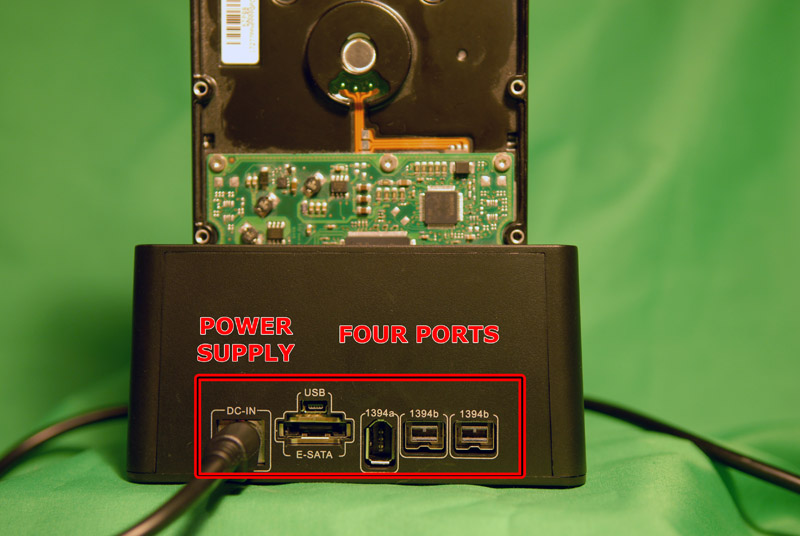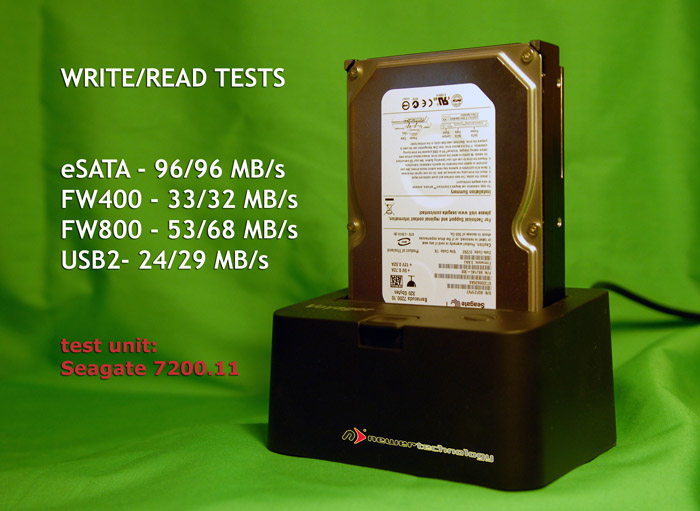Archiving solid state
video media is either CONVENIENT, RELIABLE, or INEXPENSIVE, but
seldom all three. DLT or LTO tape solutions are reliable, but
are slower than random access devices, and usually pricier. Single
or dual layer DVDs are time tested, but are constrained by limited
capacity. Blu-ray™ burners and blank media are still expensive
and long term storage is still untested. HDDs have two strong
positives: convenience and inexpensive, and the highest negative
-- they can and eventually will fail.
With this criteria in mind, I evaluated
Newer Technology's Voyager (Q) -- an inexpensive, versatile and
convenient dock station that archives media to bare 2.5 and 3.5
inch SATA drives. The drives insert into the Voyager and lock
in place in one motion. Drive access to your computer is achieved
using eSATA, FW400, FW800, and USB2 ports which are located on
Voyager's back side. The device doesn't eliminate every HDD backup
strategy concern, but its convenience and ease-of-use provides
additional safeguards - fast, inexpensive, and REDUNDANT backups.
What's In The Box. Less expensive USB2/eSATA drive docks are available,
but the Voyager is the first to ship with four connection interfaces.
It measures 5.28" x 3.70" x 2.68" and weighs about
1.35 pounds. Constructed of ABS plastic, four rubber feet hold
it in place. Despite its plastic construction, the Voyager feels
fairly solid.
3.5-inch SATA I or II bare drives insert
port/power side down into a hinged top flap that moves backward
as the drive locks into place. Smaller 2.5-inch drives fit slightly
to the backside of the same slot. FW400 and 800, mini-to-standard
USB2, and SATA cabling is provided. An external brick power unit
cable attaches to the back side, and protrudes away from the
unit. I don't care for this arrangement. Most Macs and some PCs
have Firewire and/or USB2 ports, but you must supply a SATA card.
The Voyager utilizes the latest Oxford 934DSb bridge chips for
the 1394a and 1394b ports. The mini USB port sits above the eSATA
port. Drive activity and power on status are indicated by red
and blue LED lights.
Versatility.
The device is fairly easy to use. Drop your bare SATA drive into
the slot on the top of the device, and it securely clicks into
place. Connect the appropriate cable, turn the unit on, and the
drive mounts on your desktop in five to ten seconds. No drivers
are required.
Unmount/eject the drive from your the
desktop and press the release button at the top of the Voyager
to unlock and remove the drive. Drives can be hot-swapped and
used as boot drives on a Mac. No cooling fan is needed because
the bare drive is open to air ventilation. As indicated earlier,
I would prefer a less open and more robust power connection at
the unit. Be careful to support the power cord on a flat surface
with minimal tension at the connection and securely attach it.

Data Backup.
My test drives included Maxtor, Hitachi, Western Digital and
Seagate SATA mechanisms. All worked as expected, including two
with dual ATA and SATA power connectors. A Seagate 500 GB 7200.11
32MB cache drive returned a 96 MB/s write/read benchmark using
a Tempo™ SATA E2P board installed in my MacPro. When installed
internally on a drive carrier in same computer, the Seagate returned
a 105 MB/s write/read.
USB2, FW400/800 speeds were consistent
with theoretical limits. Firewire 400 produced 33/32 MB/s write
read. USB2 reported 24/29 MB/s, and Firewire 800 was 53/68 MB/s
write/read. Although NewerTechnology claims 300 MB/s for SATA
transfers, I saw nothing close to that benchmark. I didn't test
every protocol for 2.5-inch SATA drives, but eSATA returned a
50/50 MB/s write/read using a 320 GB Hitachi 5400 rpm TravelStar
drive.

The Voyager is also a versatile and convenient
tool in your daily computing tasks. For example, I used it to
reinstall my pro apps from dmg images, to quickly access data
backups, and clone clean installs of OS and apps for use if my
primary drive went down. All video archive drives are stored
in protective static free containers in a dark, cool, and clean
room. The device is pricier than two interface similar docks,
but adds value and versatility over these devices.
Copyright ©2009 David
A. Saraceno
David A. Saraceno is a motion graphics artist located in Spokane,
Washington. He has written for DV Magazine, AV Video, MacHome
Journal, and several state and national legal technology magazines.
David moderates several forums on 2-pop.com,
contributes as a Level IV as the Apple Discussions, and is active
at dvxuser.com.